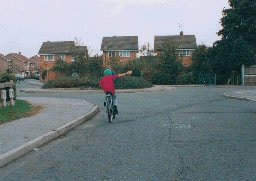Scan QR code or get instant email to install app

Question:
You are approaching this roundabout and see the cyclist signal right. Why is the cyclist keeping to the left?

Cycling in today’s heavy traffic can be hazardous. Some cyclists may not feel happy about crossing the path of traffic to take up a position in an outside lane. Be aware of this and understand that, although in the left-hand lane, the cyclist might be turning right.
Related Information
How to cycle in traffic?
1. Begin with proper road positioning.
Check that your road position isn't too close to the kerb.
Keeping away from the gutter increases your visibility to traffic and allows you to avoid muddy drain covers, potholes, and debris on the side of the road. Also, if someone does overtake you too closely, you have greater room to turn to the left.
If you don't want a motorist to overtake you, you may need to ride further out from the kerb since it would be unsafe. Some traffic-calming measures, such as kerb-side pedestrian refuges, do not provide adequate space for a car to safely pass a cyclist.
Moving to the centre of the lane should result in drivers staying behind you rather than trying to pass you. Some people refer to riding in the centre of the lane (where most motorists drive) as 'taking the lane' or the 'primary position'.
2. Keep an eye on what's going on around you.
Road awareness is a valuable skill to cultivate.
Looking ahead for uneven surfaces, drain covers, road humps, cars parked in the lane, potholes, and puddles is essential (which can hide potholes). Looking around also helps you prepare for intersections, roundabouts, traffic lights, and other possible hazards. This keeps you from having to swerve, brake suddenly, or make unexpected manoeuvres that other drivers aren't expecting.
3. Developing a sense of anticipation
All road users can do things you would not expect.
You can't control what other people do, but you can keep an eye out for distracted pedestrians, dogs that aren't on leashes, youngsters playing a football by the side of the road, and drivers who have their phones to their ears. Once you've spotted something or someone that has the potential to cause a problem, you should remain vigilant so that you can respond as needed.

Comments
Ahmed Ahmed
3 years ago
ok
Shane Ebanks
3 years ago
Great studying tool!
Peter Turner
3 years ago
Perfect!